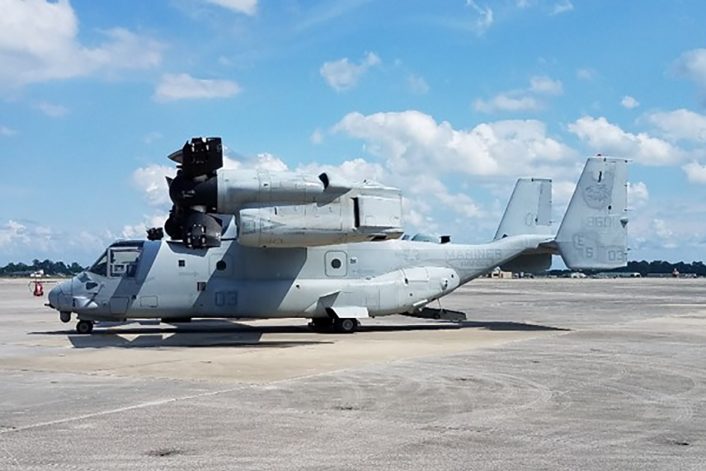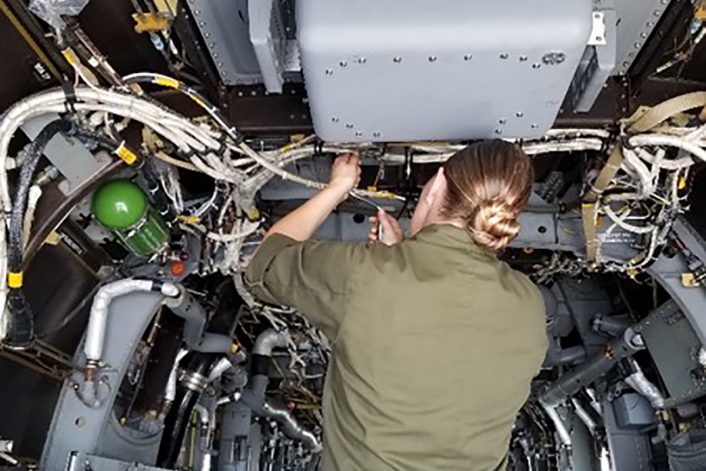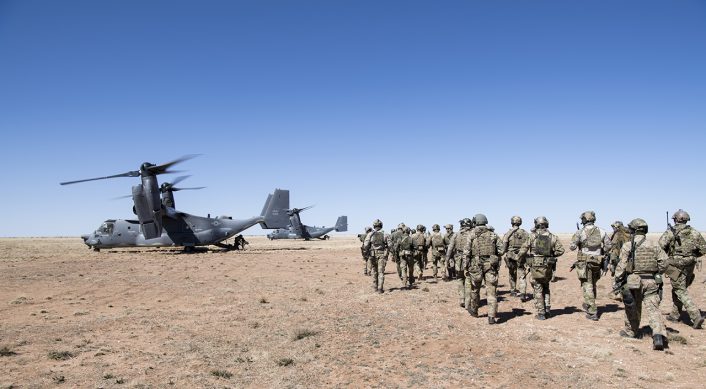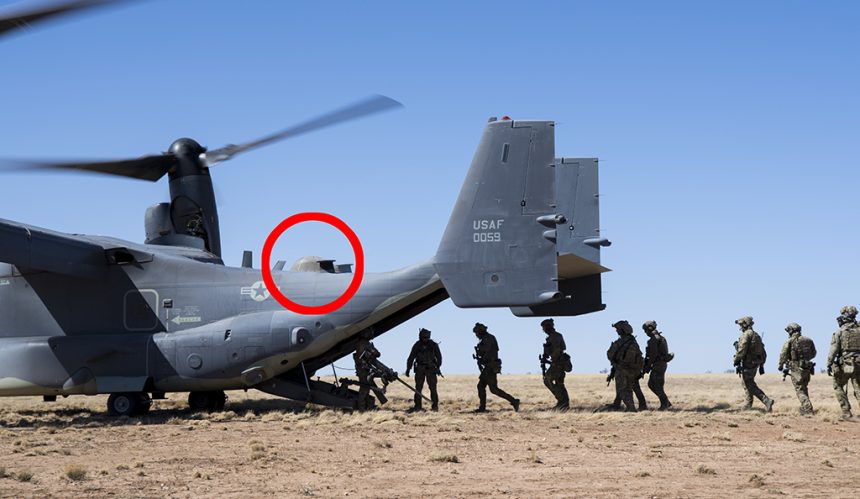The new “bulge” is a radome for the Ku Ka antenna used to interconnect the CV-22s and MV-22s to a complex system providing secure voice and chat, classified network access and much more.
If you browse through the huge amount of photographs regularly released by the DoD, you’ll notice that some of the Air Force Special Operation Command’s CV-22 and U.S. Marine Corps MV-22 Ospreys have been modified. The tilt-rotor aircraft now sport a new “bulge” on the upper fuselage between the wings and the tail. After a quick investigation we have found that the “bulge” is actually a radome hosting a SATCOM antenna quite similar to the one used aboard airliners to give passengers the ability to stream Prime Video or Netflix live on their mobile devices while airborne.
The antenna is aimed to give the Ospreys the ability to interconnect to classified (and unclassified) networks with increased bandwidth and transparent transitions among multiple satellite beams in process: this significantly improves Situational Awareness, as the Osprey can get tactical details and access secure channels in a reliable way while enroute. The problem faced by the V-22s (both the U.S. Air Force CV-22s and the U.S. Marine Corps MV-22s) as well as other assets, is the changes occurring during a long air transit to the target area. The battlefield is a extremely dynamic scenario with forces in continuous movement. A Special Operations aircraft launching from a Forward Operating Base located at 1-hour flight time from the area of operations may find a completely changed tactical situation than the one briefed before departure by the time it gets there. Describing the need to be constantly updated, the commanding officer of a Special Purpose Marine Air-Ground Task Force said in a news release: “As an infantryman, it’s very frustrating when you’ve fully planned a mission. Then after a long air transit to the objective area you get off the plane and find out everything is different … rules of engagement, enemy locations, even the objective itself.”
For instance, during the civil war in South Sudan, Marine Corps MV-22 Ospreys flew a Marine response force from Spain to Djibouti in a non-stop flight of 3,200 nautical miles – the distance from Alaska to Florida. But U.S. Marine Corps crisis response units for U.S. Africa and U.S. Central Commands aboard MV-22 Osprey and KC-130J aircraft were typically disconnected from intelligence updates, tactical data sources and each other while flying to a crisis hot spot. This means that but needed a capability to conduct mission planning, and command and control when flying to distant objective areas.
For this reason, it is extremely important that the aircraft is constantly fed with relevant updates while enroute .
Dealing with the MV-22s, the antenna is part of the Networking On-The-Move-Airborne Increment 2 (NOTM-A Inc 2) initiative launched in 2016. It includes a suite that can be fitted to the KC-130J and MV-22 to provide an airborne en route mission planning and over-the-horizon/beyond-line-of-sight (OTH/BLOS) communication and collaboration capability. Noteworthy, the NOTM-A is capable of installation/configuration within 60 minutes, and rapid disembarkation from its host airframe in preparation for future missions. The Quick-Release-Antenna-System for the satellite communications system varies depending on host aircraft but features network management equipment and C2 components that are airframe agnostic. The system provides internal secure wireless LAN access point for staff personnel to perform digital C2 functions in the SATCOM host aircraft: in other words the NOTM-A provides connectivity for the aircrew through secure WiFi network. Interestingly, access to the global information grid and Marine Corps enterprise network can be accomplished via commercial network access.

According to the U.S. Marine Corps, in May 2015, the first NOTM-Airborne Increment I (also known as the Hatch-Mounted Satellite Communication Antenna System) was fielded to Special Purpose Marine Air-Ground Task Forces. It gave embarked ground personnel real-time access to networks during airborne operations aboard KC-130 aircraft. As a consequence of the success with the Super Hercules, the Marine Corps decided to install NOTM-A Inc. II on the MV-22 and, in June 2018, the first of the systems was fielded to the 22nd MEU (Marine Expeditionary Unit).
“It can take hours to fly to a location to complete a mission, and during that time, the situation on the ground can change significantly,” said Chris Wagner, NOTM lead engineer in MCSC’s Command Element Systems in an official news release. “The NOTM capability provides Marines with real time command, control and collaborative mission planning while airborne.”

In order to accommodate the new system, the Naval Air Systems Command and MCSC had to modify the Osprey: “This involved modifications such as replacing the rear overhead hatch, installing a SATCOM radome, and installing system interface cables. Mission ready, the system is capable of providing communications access for up to five users, including networks, voice, email, video and text.
With the new equipment, the MV-22 aircrews can get accurate and up-to-date en route information: “If the situation on the ground changes, we can get updates to the Common Operating Picture, from reconnaissance assets to the commander enabling mission changes while en route.”
Testing with the MV-22 took place November through December 2017 at Naval Air Station Patuxent River, Maryland. Marine Expeditionary Forces I and II will receive the NOTM-A Inc. II System when fielding continues in 2019.
When it deals with the modification to the U.S. Air Force CV-22, little details are available. Most of the information comes from Powerpoint deck (in .pdf format) that you can find online. The slides, dated 2016, are part of a presentation on Airborne Mobile Broadband Communications by ViaSat Inc. a global broadband services and technology company based in California that provides satellite communications service for government, defense and military applications.

The presentation includes interesting details about the SATCOM antennae used to connect to ViaSat services by C-17 airlifters, AC-130U gunships, Air Force One and VIP aircraft (including C-40 and C-32), RC-135 Rivet Joint spyplanes (both the U.S. and UK ones) as well as MV-22 and CV-22 tilt-rotor aircraft. Dealing with the latter ones, the presentation states that at least 6 shipsets had already been delivered to AFSOC for the CV-22 Satcom System and Service whilst the initial 4 shipsets for the MV-22 Satcom Systems had been contracted. Based on this, it looks like the system used by the U.S. Marine Corps MV-22 and CV-22 is the same (as one might expect): it offers a kit with easy roll on/roll off capability, maintenance and upgrades.










